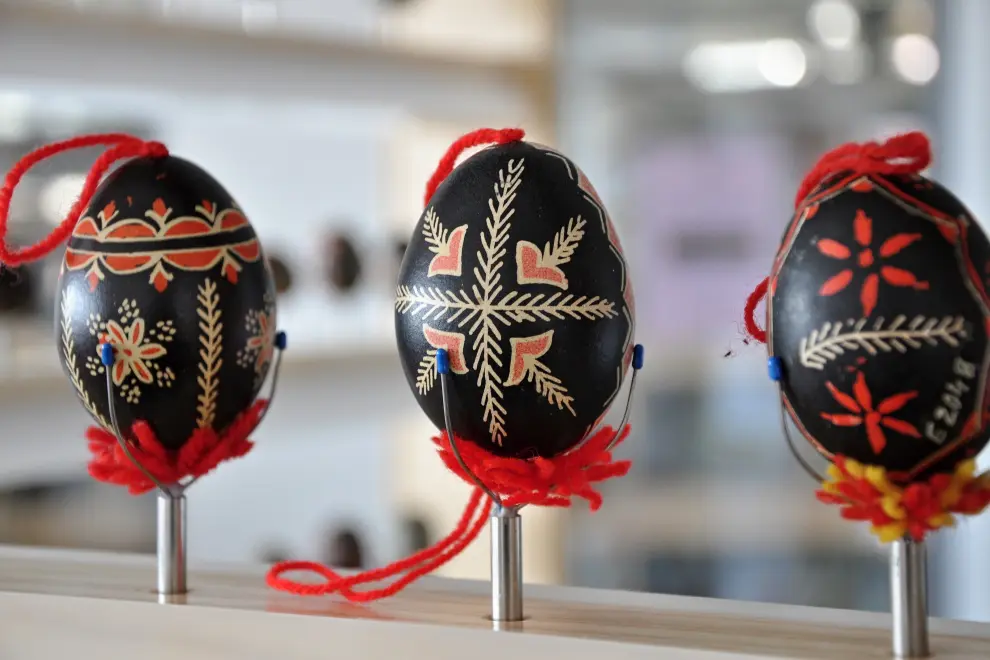Easter egg decoration, an art passed down for generations
Decorated Easter eggs or pirhi are an important part of Ester tradition in Slovenia, dating back to the 17th century. In many places it has evolved into an art of making elaborate decorations that is passed down from generation to generation.
The motifs and methods of Easter egg decoration vary from one region to another.
In Bela Krajina in the southeast of the country, wax is applied on eggs before dyeing to create artfully ornamented pisanice in Adlešiči. In Metlika, the eggs are first cooked with onion skins to dye them before various motifs are engraved into them with a knife to make drsanke.
Similarly, two methods are used in Prekmurje in the northeast; eggs are either first dyed using natural dyes such as onion skins and then engraved to create škrabanke, or the reverse process is applied where a special pen is used to draw a motif with beeswax before they are dyed to make remenke.

Pisanice, Easter eggs from the region of Bela Krajina. Photo: Rasto Božič/STA
In Suhorje in the southwestern region of Brkini, dyed eggs are engraved to create decorations typical of the region. The tradition there is kept alive by Jadranka Kristina Volk, 85, who learned the skill from her mother and has passed it on to her daughter and granddaughter.
The Suhorje pirhi have a long tradition. Kristina Volk says almost every house in the village used to make them before the Second World War, but as the country adopted socialism after the war the custom almost died out.
Her mother, Antonija Volk Krebelj (1908-2002), kept the tradition going, engraving eggs up to the age of 94. She inspired her daughter, who first decorated the eggs in secret. "My mum was very precise in her technique and therefore very critical," she says.
Being a custom in the family to have pirhi adorning the Easter table and presenting them as gifts to relatives and friends, Jadranka took up the engraving for earnest after her mother's death.
She still has skilful hands today, and she has also taught her daughter Kristina Dekleva and granddaughter Ana Dekleva-Čotar the art. The tradition has been in the family for at least 170 years, now passed down to the sixth generation.
Since 2022, the decorating of the Suhorje pirhi has been listed in the register of intangible cultural heritage, along with the making of Bela Krajina pisanice and the Prekmurje remenke.
The Suhorje pirhi are most often made of chicken, goose or duck eggs. When ostriches were farmed in the area at the end of the 20th century, ostrich eggs were sometimes used.
The eggs are first dyed. Kristina Dekleva says that in the past, they were most often dyed with pražilka, where the eggs were soaked with the bark of Brazilian wood which gave them their red colour. Nowadays, the eggs are mainly dyed with onion skins, which give them a distinctive brown colour, or store-bought dyes.
The eggs used to be engraved using a razor blade or scissors, but now utility knives are used. "My mother Antonija used to engrave full eggs, but now we have been blowing them out for some time to make them hollow so they last longer," Jadranka Kristina explains.
The most common motifs of the Suhorje pirhi are floral such as carnations and bouquets. Also popular are little boats, hearts, birds with an olive branch, and a symbol of faith, hope and love. Jadranka Kristina's favourite motif is the little lamb.
The traditional motif of a bouquet featuring hearts as blossoms has also been passed down in the family. It was used as a commemorative postmark by the Prem post office on Maundy Thursday in 1995.
Today, the traditional motifs are complemented by new ones.
Since 2016, the Suhorje Village Association has been organising the annual St Joseph's and Easter event. In the run-up they organise a workshop in the Suhorje village hall to make the pirhi. These are then exhibited along with other products related to Palm Sunday and Easter.


